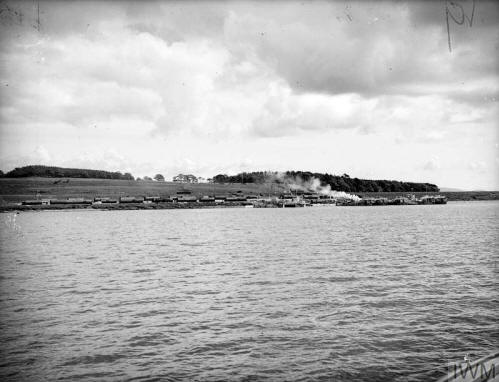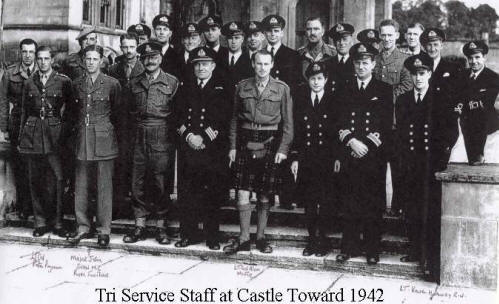|
No 2 Combined Training
Centre - HMS
Brontosaurus.
Castle Toward,
Dunoon, Argyll

Background
HMS Brontosaurus,
Castle Toward, Dunoon, Argyll was the No 2 Combined Training Centre
(CTC),
informally known as CTC Castle Toward (pronounced as in coward). It
trained officers and crews to operate 'major' landing craft in preparation for
amphibious landings onto unimproved landing beaches in North Africa, the
Mediterranean, Normandy and other locations.
[Photo;
Hoppers pier at HMS BRONTOSAURUS, 6 miles from
Dunoon on the River Clyde. Jimmy the One huts stretch out along the shore and up the
hill right of centre. © IWM (A 29908)].
The No 1 Combined Training
Centre at nearby Inveraray did the same thing using 'minor' landing craft,
a distinction
that only signals the size of the craft and not their importance.
All photos, unless otherwise stated, are courtesy of
Lt Col D B Peyman,
while this account is based on research material supplied by Phillip C Jones.
T raining raining
Initially the Training Centre provided basic Royal Navy
training in seamanship and the operation of 'major' landing craft for the
officers and crews. The sailing characteristics of these flat bottomed,
square ended craft was very different from conventional craft with sleek
lines and heavy keels.
In November 1942,
the ground force element from
HMS Dundonald (the troops to be carried
in landing craft to the landing beaches) was transferred to
Castle Toward and Inveraray about the time the Commandos and Infantry
Battalions were receiving training in amphibious operations. Toward's remit,
therefore, expanded to accommodate the training
of
officers and men of the Royal Navy, Army, RAF Regiment and ground
crews in combined amphibious operations. A variety of major assault
landing craft were used, such as Landing Ship
Infantry (LSI), Landing Craft Tank (LCT) and Landing Craft Personnel (LCP). The
skills and procedures for safely
embarking tanks, vehicles and personnel
and their disembarkation
in mock landings onto unimproved 'assault' beaches, were regularly rehearsed
until perfected.
The training was in preparation for
future landings
including, Dieppe,
North Africa (when a large
contingent of U.S. forces was trained at both Castle Toward and Inveraray),
Sicily,
Italy,
Normandy and Walcheren.
Photo Gallery
Hover over the
thumbnails for information on the photos and then click to view.
Reminiscences
Visit of Vice
Admiral Lord Louis Mountbatten 16 December '42.
I remember this occasion very clearly. It was a
typical Scottish winter's day, blowing a howling gale, pouring with rain and
bitterly cold. Mountbatten was due to visit Castle Toward at mid-day. Like every
good WO, the Chief Petty Officer got the men of the establishment on parade at
least half on hour before the V. Admiral was due to arrive. 12 o'clock came and
went and we still awaited the illustrious inspecting officer, all the time
getting wetter and wetter and colder and colder. Finally, after a delay of one
and a half hours, Mountbatten appeared. By then the ratings and soldiers had been
on parade for two hours.
The parade was drawn to attention and the
commander invited Mountbatten to carry out the inspection. So far as I remember,
the parade consisted of what the navy call divisions and what the army would
describe as companies or squads. In both cases, about 30 men each.
 Mountbatten
first inspected the naval divisions and, as soon as he had inspected a division,
the officer in command ordered the men to 'Right Turn - Quick March', and off
they went through the Scottish mist and rain back to their Jimmy the One huts. Mountbatten
first inspected the naval divisions and, as soon as he had inspected a division,
the officer in command ordered the men to 'Right Turn - Quick March', and off
they went through the Scottish mist and rain back to their Jimmy the One huts.
When Mountbatten had
inspected the fourth naval division, he turned to the parade commander and asked
him why authority
was being given, without his permission, for the men to be marched off parade
once they had been inspected. I do not recall what sort of a reply the
unfortunate officer gave, though I am sure he would have liked to have said
something like, "You arrogant sod, it's because the men have been on parade for
two hours, are wet through and frozen stiff."
Whatever the parade commander may have said,
he got short shift from Mountbatten, who ordered all the men to be brought back
on parade. I don't need to tell you that the Noble Lord was
not greatly loved that day.
Centre Staff
CTC Castle Toward was under the command of a
Captain RN with tri-service instructors. Below are details of the training and support staff and their duties
sometime in 1942/43, which provides an insight into the diverse nature of
the training undertaken.
Naval Commanding Officer -
Commander B Dean (Retired) DSO RN.
Replaced by Commander R A Cassidi RN.
Replaced by Commander N N Whatley RN Commander in Command Nov '43.
Captain J D Harvey RN, Chf Naval Staff Officer Aug '43; Major W Marjoribanks, DAA & QMG; Major D Alexander RA, GSO 2; Captain E Spickett-Jones, Messing Officer; Lt CS Douglas KOSB, Instructor Infantry; Major J M Shaw MC RFus, Instructor Infantry; 2/Lt A Denholm, RAInstructor RA; Capt E Brasier-Creagh MC RA, DAA & QMG; Lt C Adams, Admin Officer; Captain P B Peyman, GSO 3; Lt R Findlay R Sigs, Instructor Sigs; Captain W Leigh Taylor RASC, Instructor RASC; Lt Harwood RN, Gunnery officer; Lt Fairhurst RTR, Instructor RAC; Major J Kelway RA, GSO 2; Captain F Fairhurst RTR, Instructor RAC; Lt R Galloway RNVR; Beachmaster; Lt B Burrage REME; Instructor REME; Sub Lt Howarth, Beachmaster; Lt (QM) J A Dunlop, QM; FI Lt C B Savory RAF, Air Staff Officer; Captain Radcliffe, Staff Captain (A); Capt A Denholm RA, Instructor RA; Lt Wright; Asst Camp Comdt; Lt L Edgar RE, Instructor; Lt K Hathaway RN; SO (N) (posted Sep '43); Captain T G Lewis; Chaplain; Brigadier A W Lee; Com'dt CTC Castle Toward I; Colonel H Clark, Colonel Commandant; Lt Col A F Young OBE, Brigade Training Officer
and Lt Colonel D Macfie, Camerons GSO 1.
Further Reading
There are around 300 books listed on our 'Combined Operations Books' page which can be
purchased on-line from the Advanced Book Exchange (ABE) whose search banner
checks the shelves of thousands of book shops world-wide. Type in or copy and
paste the title of your choice or use the 'keyword' box for book suggestions.
There's no obligation to buy, no registration and no passwords. Click
'Books' for more information.
Correspondence
Victor Frederick Golder ex RN, Service Number was C/JX 548491. Rank of AB LC/SIG.
Dear Geoff,
Iíve just
made a donation to the Combined Ops Memorial Fund, having been prompted by a
chance conversation with my Father about his National Service training.
Dad is Victor Frederick Golder ex RN
now aged 83yrs. His Service Number was C/JX 548491 and held the rank of AB
LC/SIG. He has some memories of his time at HMS BRONTOSAURUS and remembered
that it was a Combined Ops training establishment, but didnít recall that it was
at Castle Toward. He was there for signals training. He spent his War Service
drafted to minesweepers and LCTs and was one of many that embarked troops who
landed on D-Day beaches.
I have found your web-site
exceptionally useful and informative, not least of all because I am preparing
for Dad a summary account of his Service life, brief though it was (he
volunteered at age 17 in 1943 and was demobbed in late í46). When I have tidied
up a few of the photos that I have of Dad and his mates on board LCTs, I will
pass them across in case they stimulate memories in others. In the family he
was known as Joff, maybe that was carried into the Service. Do you have an
appropriate tag within the website to post these (all too brief) details of my
Dad at Castle Toward. I would love to find out if there is anyone that
remembers him.
 Thanks
in anticipation. Stay safe, Regards, Steve. Thanks
in anticipation. Stay safe, Regards, Steve.
Sub Lt Islwyn Vaughan RNVR
 This photo includes my father and I'd love to hear from anyone in the photo or
anyone who has any information about it. My father was Sub Lt
Islwyn Vaughan RNVR. He served as follows in combined ops; i) 5th LCP (L) Aug 1942 - Deippe,
ii) 520th LCA July 1942 - Point De Hoc, Normandy & iii) Nov 1944 509th Flotilla at E Schelts & Holland This photo includes my father and I'd love to hear from anyone in the photo or
anyone who has any information about it. My father was Sub Lt
Islwyn Vaughan RNVR. He served as follows in combined ops; i) 5th LCP (L) Aug 1942 - Deippe,
ii) 520th LCA July 1942 - Point De Hoc, Normandy & iii) Nov 1944 509th Flotilla at E Schelts & Holland
 Many thanks in
anticipation. Rob Vaughan. Many thanks in
anticipation. Rob Vaughan.
Charles Carmichael
My grandfather, Charles Carmichael, served in the RAF Regiment as an
AC2 with No. 2777 Squadron. The squadron operations record book is
very brief but contains the following entry concerning training
courses.
Gosport
25.6.43 a.m, Lecture to squadron by Lt.Col.
Young
26.6.43 p.m., Squadron proceeded to Castle
Toward for CTC course
Castle Toward
1.7.43 a.m. Squadron
witnessed landing craft demonstration, Inveraray
2.7.43 a.m. Squadron in
exercise PRUNE I
2.7.43 p.m. Swimming
instruction in full kit. PO Joels arrived from Compton Bassett
3.7.43 a.m. Squadron in
exercise PRUNE II
3.7.43
p.m. Squadron in
exercise Straddle
4.7.43 Squadron
completed exercise Straddle
6.7.43 a.m. Squadron leaves
for Gosport
In August
1944 my grandfather was transferred to No. 2742
Squadron RAF Regiment. That squadron was also at Castle Toward in 1943 from
18-24 May for what was designated as No. 12 Combined Operations Course.
Ian Young

|

 raining
raining



